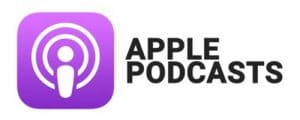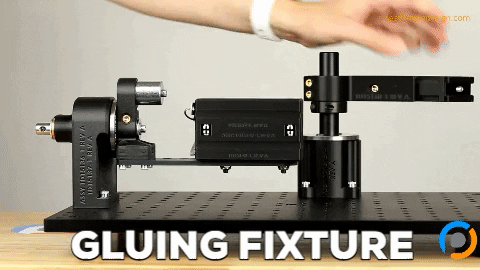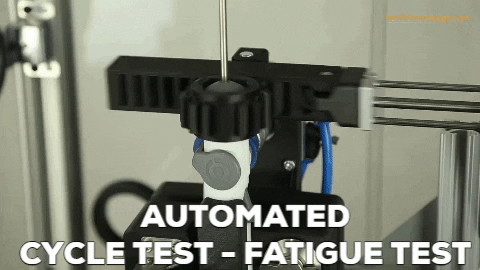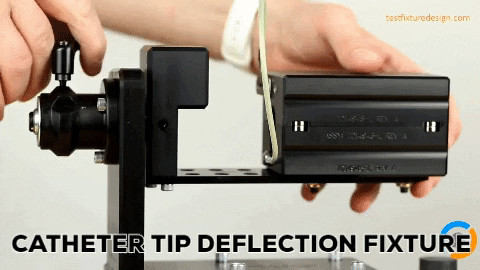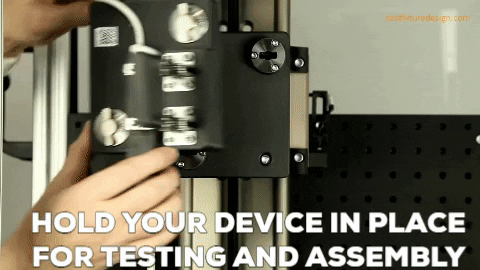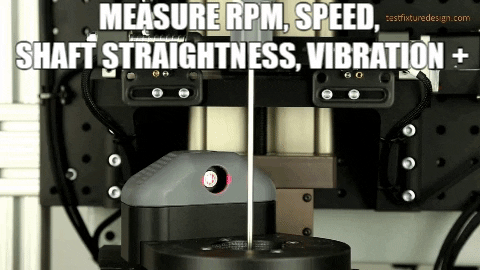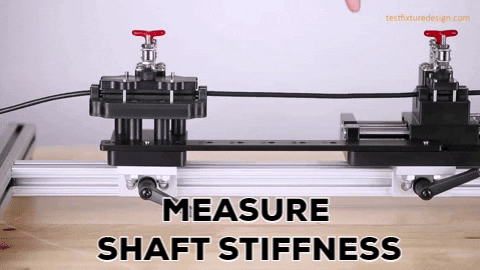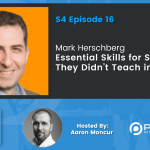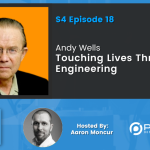Julie Schulte | Parts & Hardware Tools for R&D Engineers
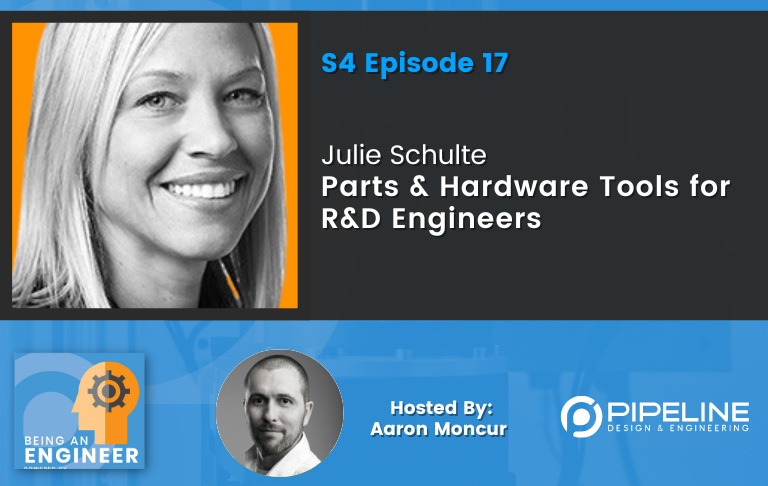
Who is Julie Schulte?
Julie Schulte is co founder and CEO at Chamfr, where their goal is to help make product development faster by connecting engineers with suppliers of medical components. If you are an engineer in the medical device space, this episode is for you.
EXPAND TO VIEW EPISODE TRANSCRIPTION
Presenter 00:00
Hi, everyone, we’ve set up this being an engineer podcast as an industry knowledge repository, if you will, we hope it’ll be a tool where engineers can learn about and connect with other companies, technologies, people, resources and opportunities. So make some connections and enjoy the show.
Julie Schulte 00:18
I actually went back to the CEO and I said, this is our vision, like that was a PowerPoint, this solution doesn’t exist. And he said, Yeah, you guys will figure it out. You’ve been in the industry forever. You’re passionate about it. Just go get it done. And so we were like, if we cash this check, there is no turning back.
Aaron Moncur 00:45
Hello, and welcome to another wonderful episode of The being an engineer Podcast. Today, we’re speaking with Julie Sheltie, who is co founder and CEO at Chamfr, where their goal is to help make product development faster, like connecting engineers with suppliers of medical components. If you are an engineer in the medical device space, this episode is definitely for you, Julie, welcome. And thank you so much for being on the show.
Julie Schulte 01:10
Thanks, Aaron. Excited to be here.
Aaron Moncur 01:13
So we’re gonna talk a lot about Chamfr. And how engineers benefit from Chamfr. Before we get into that, can you tell us a little bit about your background? What What were you doing prior to Chamfr?
Julie Schulte 01:24
Sure, I’ve been in the med device space for 20 years, almost exclusively in contract manufacturing. So the first 10 years of my career, I was actually selling to engineers. The last 10 years of my career, I was leading Sales and Marketing for contract manufacturing companies and various C suite roles.
Aaron Moncur 01:42
Okay, so if at some point, you decide that you either want to stop doing what you were doing, or you want to start doing something new, and maybe some combination of the two, how did Chamfr come to be?
Julie Schulte 01:55
Yeah, it was definitely a combination of both. I was frustrated by not being able to service engineers at their point of need, actually, and had an opportunity to start a company because the company that we I was working for was private equity owned, and it divested in 2017, meaning we sold the business off to two different companies. And at that company, which was a large contract manufacturer, at the time, several 100 million, we had started the first single vendor e commerce Store in med device, and people thought we were crazy. But having grown up trying to service engineers, I knew that they really struggled to source low volume components early on in the design process. Conversely, operations struggled to make the small volume requests and break into manufacturing to service them. So we thought if we created components in low volumes, and just made them accessible to engineers at the click of a button, that would accomplish both needs that were between the service the sellers and the buyers,
Aaron Moncur 02:57
and what what qualifies as low volume.
Julie Schulte 03:01
Any anything an engineer needs early on in the product development process. So I mean, I had several engineers saying, I just trying to figure out what my actual product, you know, needs are and finalize my spec. So they were like, Can I get one z two z’s, you know, 1020, whatever, just to iterate within the r&d Lab, and it’s really difficult to break into manufacturing for that type of request. And they were had to create a spec, because nothing existed when they weren’t even sure what the spec was. So it was sort of a chicken and an egg type thing.
Aaron Moncur 03:34
I know, in my own efforts, trying to source things, sometimes I’ll find what I think is the perfect part. But they have a minimum order quantity of like, you know, 2000 parts or something like that, and I need one or maybe two. Yeah, so I definitely get the need there. Sometimes, a supplier would be willing to provide samples, right. But other times, they’re like, No, you got it, you got to buy 2000 for them. So
Julie Schulte 03:59
even if they’ve got samples, I actually owned a product development consultancy, that I had co founded with a couple people. It was focused on interventional and bio electronic spaces, and our engineers were trying to get small volume components and they’d find the supplier and it would show that they’ve got this you know, sample locker online and they pick up the phone and try and call somebody and they couldn’t get ahold of somebody and when they did get a hold of somebody they weren’t sure where the inventory was or if they actually had it in stock and so just the manual workflow really wasn’t working efficiently and effectively for either side the buy or the sell side.
Aaron Moncur 04:37
I don’t know if you can speak to this or not but what why is it such a problem? Like why can’t suppliers just have a process set up to deliver small volume quantities to r&d teams? What Why is that even an issue?
Julie Schulte 04:50
Well, they can now with Chamfr.
Aaron Moncur 04:54
though before Chamfr Why Why couldn’t they?
Julie Schulte 04:57
I mean there’s a couple issues. It’s you know when you think about designing a medical device from scratch, you are starting with a blank sheet of paper, right? So you might know you need a, you know, a polyamid tube, for example, but you don’t know the exact specification. So you’re creating a document that says, here’s what I need, but you’re sort of guessing at that point, because you don’t have the device, you know, specification defined, right? And so then you have to go to the supplier and figure out who can meet that specification. And then the supplier has to then not only say, Yes, we think that’s within our capability range, but then go on to the floor and have the manufacturing people actually make it. So in the old model, there was nothing close enough, there was nothing off the shelf. And this is actually one of the things that it was hard for people to get their head around is like, well, the engineers bring the need. And I’m like, well, they’re creating a need, because they don’t have anything to try early on in the process. Right. And so that’s really what we tried to achieve.
Aaron Moncur 05:56
So it sounds to me like, ultimately, the answer is or was, people weren’t or suppliers weren’t carrying inventory, they weren’t carrying any stock of these, like really custom sized things, because they had no idea people were going to buy something like that, is that
Julie Schulte 06:13
Exactly. And that’s still a challenge today. But we’re saying, hey, the engineers just need something close enough, create inventory that represents your capability range, so that they can tweak and play and, you know, try different things so that they can get closer to understanding what they need. That didn’t exist before. And in fact, it is an investment for the supply side. So we’ve had to convince them that this is super valuable for engineers, and they will go to, you know, what we call the toolbox. So Chamfr, just at a high level is essentially like an Amazon for medical device components specifically. And there’s, you know, we have 1000s of components from, you know, 40 plus sellers right now. And it’s just a toolbox for our ingenious r&d engineers to go in, but they’re buying from a toolbox of suppliers that understand what it’s like to provide supply to medical device, you know, so they understand the regulatory requirements, they understand, you know, what sort of quality systems they need in place, therefore, the buyers can use them throughout the entire lifecycle of the product.
Aaron Moncur 07:15
Yeah. So I think this is super interesting. And I want to provide even a little bit more history for especially maybe some of the junior engineers out there who have never even been exposed to the supply chain issues and didn’t even know that it would be a problem to get parts in in low quantities. What did engineers do before chamfer? To solve this problem?
Julie Schulte 07:38
Great question. Yeah, I mean, they basically went online, if they didn’t know who the supplier was of a particular, you know, material or component capability, they went online and Googled it. And assuming you could find a good representation, they usually went to several different suppliers, provided them a specification of something that was just sort of at that point, you know, a shot in the dark, the suppliers would then have to respond to them and say, yes, it’s within our capability set, they would request a quote for these small volumes, and they’d go back to their operations team, create the quote, get it scheduled in a manufacturer, if they even agreed to do it. Because again, just to say, one of the challenges was, if I was talking to an engineer, and he knew what he needed, then I had to convince my ops team that it was worth spending time, even if the engineer was willing to pay 1000s of dollars for like, you set a minimum lock fee, right? So then they’d have to wait for the quote, get the quote, and then the quote would be associated with the lead time. So you think about when you’re trying to source components for a bomb, and let’s say, just to simplify, you have 20 Different components on a bomb, this sort of process could delay any one component or all of them, and you just stack up the amount of time it takes to get anything, any iteration of a device in my device exponentially, right? And then the costs associated with our exponential to because you’re paying minimum lot fees for 20 Different components with 20 Different lead times from 20 different suppliers, assuming you could even find the right supplier for what you were trying to source for. It was extremely inefficient, which is, you know, again, why we said there has to be there has to be a better way.
Aaron Moncur 09:13
I love it. I love it. Quick, quick tangent here. Chamfr is spelled C H A M F R no E between the F and the R. I’m curious. How did you come to that spelling?
Julie Schulte 09:26
That’s right, Aaron. And they thank you for saying that. Because I don’t know that. That’s why they know but it is intentional. So we did drop the E. When we thought of the name, it was sort of like a light bulb moment. And we said, oh, you know, isn’t that sort of like a blunt edge, giving engineers an edge to innovate faster, and we were just pumped because honestly, we had come up with 50 names that were horrible. And we’d been trying to find the name for the business for several months. And we went online and just look to see if there was you know, we can get access to the domain and we have to make sure that we could you know, rank in the Google’s Don’t rankings and all those things so that engineers could actually find us since we are a new company and the way we could own the entire space was to drop the E and not compete with, you know, other terms. So that’s, that’s why we ended up selling it that way. Yeah.
Aaron Moncur 10:12
Well, I love the name, I think it’s perfect because it almost filters out the people you don’t want and attracts the people you do want. As an engineer, I hear a company called Chamfr. And I think, oh, Chamfr. I know what that is. That’s design that’s mechanical. That’s CAD, that’s engineering. And like, immediately, I want to learn, okay, what does this company do? But if I’m not in the engineering space, if I’m not your customer, I hear Chamfr. And I think, oh, that’s some kind of like geometry thing. I don’t want to touch that. So that seems perfect to me. I love it. Well, okay.
Julie Schulte 10:42
So since we’ve gotten there, I just have to tell you, the funny thing is, so I’m not an engineer, but I’m married to an engineer, my entire career has been been servicing engineers. My co founder, one of my co founders is a mechanical r&d engineer. And I was the one who came up with Chamfr and said, Are you Is this what this means? What do you guys think? And they were like, yes, that’s the perfect term to get engineers to understand what we’re trying to do. So it was kind of fun that, that that’s how it evolved. But yeah, we want to speak directly. We are 100% targeted on servicing engineers innovating in medical device. And that’s our exclusive focus, which is different websites or marketplaces.
Aaron Moncur 11:23
Yeah. Speaking of that, being your sole focus medical devices, how did you come to that conclusion that you want to serve as just the medical device and not just, you know, industrial, general commercial engineering r&d needs.
Julie Schulte 11:36
I mean, the business model really just evolved out of trying to solve pain points that, you know, like I said, I had experienced on trying to service engineers from the commercial side. And also, one of my co founders, as an engineer had experience, you know, she was going to 50 different websites trying to find, you know, the right capability set to match what she was trying to do then picking up the phone and had a lot of frustration, different UIs different UX is, and I’ve spent my entire career on my device, it never even occurred to me and I’ve we’ve had people say, Hey, you should use this model and leverage it for another industry. But we are super passionate about med device. We no med device. We’ve been in med device for 20 years. And our goal is just to be the best at what we’re doing in med device. That’s 100%. It’s, it never occurred to me to go anywhere else i i want to stay here for for the rest of my career pretty much.
Aaron Moncur 12:26
Well, it seems like a good strategy to me. I’ve been reading Seth Godin, this is marketing book lately. Great book loves He talks about. Yeah, he’s wonderful. He talks about how it’s super critical for any business to identify what they’re going to do and and send out signals that this is the specific thing that we do, and target that on on this minimum viable market. And so it sounds like that you’ve done exactly that. It’s very clear what you do. Low volume medical device components for the medical device industry.
Julie Schulte 13:01
Yeah, we we did start? Well, we started with a minimum viable, viable product. So again, we when we started to scope, the business plan and look at the solution we were trying to bring to market we said, what’s the pain point for the engineers and the suppliers? And how do we get them to connect more effectively and efficiently to alleviate some of these pain points. But as we’ve expanded the strategy, and we’ve looked at functional upgrades, we are really focused on how do we make the buyers journey easier and continue to add value for engineers. And so what we’re, we’re really thinking about is a global network. So we’ve created this global network. And it started out just with the in stock components, but then we said, Okay, what happens after they source, you know, this low volume component, then they need to go back and either iterate on the components they got, or buy something else, right? So then we created this tool that allows them to submit an RFQ iterating on the component they got or source another component. They also said, Hey, you guys are really connected in this space. We’ve got engineers ordering from over 30 countries globally. So as you can imagine, you know, they’re not necessarily intimately familiar with supply in certain geographies or certain capabilities. They said, Hey, can you connect us with other suppliers on the service side, or suppliers that might not have inventory in stock yet, but would be able to service us in this way? So that’s how the directory actually evolved to so we are our entire growth strategy is focused on how do we add value to engineers? And to that regard, I would say if there’s any engineers with things they want to see on the site, we’re always taking feedback. And that’s how we that’s how we strap track our product roadmap for sure.
Aaron Moncur 14:40
Wonderful, wonderful. We’ve been talking about medical device components for a little while here in this conversation. Can you give us something tangible? What what are we talking about? What is the medical device component? A couple of like discrete examples might be helpful for people to hear about.
Julie Schulte 14:57
Yeah, I mean, are you talking about in terms of the offering on the site How we exactly I mean, it started out as components. And frankly, we started out in interventional because that was sort of the background of both my co founder who the engineering co founder, as well as how we grew up in the space, but we have expanded into several different markets. So we currently have, I would say, products, and I’ll explain what that means in a second. But we have it in various markets, including surgical orthopedic, bio electronic interventional. So there’s a myriad of products within those spaces. And again, just with the mindset of what is an engineer need, when they’re starting to source low volume components, they’re in an r&d lab. So while in the beginning, it started out, as you know, what you would traditionally think of as a component like marker bands, or heat shrink tubing, or a liner or nitinol tubing or a mandrel, which is, you know, can be a manufacturing aid introducers guidewires whatnot. We then expanded into both sub assemblies into tools and equipment. So yesterday, I think it was yesterday, we just launched some UV curing stations, we’re working on getting some, some adhesive on the site, we’ve got coatings on the site. So we’ve extinct we’ve gotten raw materials, actually, we had people were struggling to get resin for a while. So we reached out to some suppliers and said, Hey, would you be willing to put low volume resin on the site? And they said, Absolutely. Then they said, Well, when you when you get resin, you need a colorant. So we’ve got colorants on there. So we’ve just sort of said, if it is of use to an r&d engineer, and it’s in low volume, so they can really just play and figure out which direction they want to go and iterate quickly. And you’re willing to, you know, build or stack the material, the product, the component, the tool, the fixture. Let’s put it on there. So
Aaron Moncur 16:51
yeah, that’s a big deal these days. Is it in stock, right? I’ve come across a lot of suppliers for their website says, Yeah, we got this in stock, and then I order it and they’re like, Okay, it’ll be four weeks until they get there and I want to punch someone. So do your suppliers really have this stuff in stock? Yeah. And
Julie Schulte 17:11
We, we’ve had to work really hard. To maintain that line, we say, Hey, this is how we’re promoting it. This is what the engineer is expecting? No, you can’t just do a quick Yep, we’ll make it because you know, capacity shifts, inventory shifts, it goes out of stock. And so if it’s in the store, and it says it’s in stock, so we have a real time inventory update, if it says there’s quantity of, you know, 10 on there, and you buy all 10, it will automatically show zero in stock. And we don’t allow back ordering right now. So we do get pressure from our suppliers that say, Oh, just give us a week or two. But we we’ve held firm and said if it’s in the store, it needs to be in stock and on the shelf. And therefore they can just print out the pre printed label that gets produced when the engineer actually places the order. And they put it on the package that’s in stock, and it ships within 24 to 48 hours business hours.
Aaron Moncur 18:04
That’s awesome. I’m sure there are lots of engineers just clapping right now hearing that. So what what is the kind of the journey that the engineer goes through when they’re purchasing something on the website? So they arrive at at Chamfr? Thing is Chamfr.com, right? Correct. Yep. And then and then what happens?
Julie Schulte 18:23
I mean, there’s a couple different ways you can experience the site. But I think primarily, if you’re looking for in stock components, you just click on either the mega menu, I don’t know how much of this language translates. But you, you look for the in stock components right at the top of the homepage, it says, you know, in stock components, you click on there, and you can filter by product category, we actually have what I call the Google search bar, although that’s not It’s not Google. So that’s not Chamfr search bar, let’s say. And you can type in a supplier name, you can type in a material, you can type in a specification, and it columns the whole site, including our service partners. So I think the easiest way to source something is to type in the Chamfr search bar, because then it will show you in any product category, whether it’s a service partner or the the materials in stock on the site. But once they find the component that they’re looking for, you can filter by all of the parameters the specification, so the table at the product tables themselves, we intentionally designed somewhat like an Excel sheet. So you can filter by the different attributes. And depending on the product category, there might be something that’s more important for the engineer to filter by. So it might be ID it might be od it might be material, it might be length, you know, whatever it is the the product tables vary slightly between the product categories. And once you find the product, you’re looking for something that’s close, it’s as simple as add to cart, and we accept credit cards. They can set up a Pio if it’s required. They can use their own shipping account number if the company has, you know, a corporate account that can be put in at checkout. So it’s pretty straightforward. I mean, it’s literally a couple of clicks of a button and the product is shipped. The supplier gets notification the minute the buyer purchases order now. And so they then the clock starts and they’ve got, you know, 24 to 48 business hours to print that label out and get it out the door.
Aaron Moncur 20:17
Amazing. That’s awesome. Yep. Well, I’m gonna take a real short break here and share with the listeners that Team pipeline.us is where you can learn more about how we help medical device and other product engineering or manufacturing teams develop turnkey equipment, custom fixtures and automated machines to characterize, inspect, assemble, manufacture and perform verification testing on your devices. We’re speaking with Julius Sheltie today. Julie, what? We talked a little bit about what what engineers can find on Chamfr? Is there? Is there a type of engineer for which Chamfr is not a good fit? Like, if you’re this kind of engineer, you’re probably not going to find what you’re looking for at Chamfr?
Julie Schulte 21:03
I want to say no, because if they don’t find what they’re looking for, and they come to tell us, we might be able to solve that problem for him. But I think okay, no, I think we’re primarily focused on the r&d engineer. I mean, the site itself is intended to connect buyers and sellers, and the suppliers can service the buyer at every stage of their journey. So you know, if you think about the product development cycle, it’s like you’re starting with proof of concept in r&d. Right? And then you, once you’ve got, you know, your design, essentially, you’re moving into preclinical and clinical, so you’re still in that low volume stage. And we have had suppliers put, you know, what I would consider more than sort of the initial requirement of, you know, one Z, two Z’s or five to 10. They’ve said, Hey, can we put a couple 100? On? Can we put a couple 1000? It’s like, Absolutely, if it’s something that, you know, is fairly standard, that’s easier to do. Obviously, if it’s custom, it’s harder. But so they can, they can service them at any point in the product development cycle. And the idea is really to facilitate the introduction of that relationship directly. So another thing that’s different about Chamfr versus maybe, like a Cosina, or some of the other sites is that we have full transparency to who you’re buying from. So you can see the vendor and you can’t you know, that everybody on our site, it shows, you know, who has ISO 1345 certification right now, all of our sellers do. Some of them. It’s not a requirement, but they know that eventually to service the medical device engineer, they’re going to have to get it right. Yeah. So yeah, they can service them at every stage of the journey, which is why I don’t like to just say it’s only for r&d engineers, but that is our target audience that we’re trying to serve. Because, in my opinion, and experience, they’re underserved in our industry. And that’s where it starts. That’s where innovation starts.
Aaron Moncur 22:50
That’s right. Yeah. So I’m an r&d engineer. And I’ve ordered, you know, a few dozen components for whatever I’m testing balloon catheter or something like that. I’ve got my prototypes built, things are working. We’ve gone through some verification efforts, and we’re starting to get into production now. Am I am I still going to Chamfr to to order production volumes? Or like, how does that transition at
Julie Schulte 23:16
that point, you’re working directly with the supplier? Yep. Because you know who the supplier is, you’ve received components from them. And more than likely, you’ve had to iterate right? So it may not be an exact fit. So you can use Chamfrs online system to iterate. So if you order a specific component, you can go back in and say this was the base component that I ordered, I need this tweak to it, and it will track it almost like a Slack channel. So that you have a record and a history of what you started with for a specification and what you iterated on. And they can create the supplier can create a custom part number in there for you, and you can check out online. But at any point in the process, once that introduction has been made, you can go direct. So the engineer is then directly working with the supplier or the suppliers directly servicing the engineer.
Aaron Moncur 24:04
It sounds like to me this is wonderful that Chamfr is really just trying to make the introduction. So some of the first few parts but then if that relationship between the buyer and the supplier continues into production Chamfr is not trying to be like, Well hold on this r&d engineer. That’s that’s our customer, Mr. supplier, you need to go through us all the time. You just make the clean handoff and they can work together independently.
Julie Schulte 24:27
Absolutely. Our entire philosophy is to reduce friction and barriers not create more. So we just want an online resource that allows engineers to connect with sellers and buyers again, whether it’s services or products, raw materials, tooling, fixturing just a quicker way of sort of making that connection and finding the people that can help them get to the next step faster. And then we get out of the way.
Aaron Moncur 24:54
Nice, love it. Well, what are some of the challenges that you’ve had to overcome building aside, growing the business getting the word out.
Julie Schulte 25:04
I think the biggest, you know, the biggest one is really just getting suppliers to create inventory. Because again, there’s this, there’s this mental barrier to understanding that the reason the engineers are creating a spec at the very early stages is because nothing exists for them to purchase, right? Or at least in the old model. And so that that barrier was probably more significant than I thought it would be. Because to me, I’d been selling to engineers, for so long, I knew they were saying, Julie, just get me something that’s close enough. I mean, we can talk general French sizes, it doesn’t even have to have a specification, and you can charge me 10x, I just need to know which direction to go here. Right. And so, so trying to convince suppliers that if they created, you know, some, some samples to use your word within a certain range of sizes, it would be close enough was was a hard, hard battle to fight. But once they did a lot of our early suppliers that did get it, you know, they were the ones that said, this is brilliant, let’s do this, let’s invest in it. And they’ve now you know, exponentially increase their online offering, once they started seeing the success and saying, Oh, you’re right, you know, there’s only so many different sizes of devices, you can you can design, right? So you in the end, you’re gonna have to have an exact specification and tight tolerances and all that. But in the beginning, you’re just trying to figure out if the device even works, right. So. So once people started investing in the inventory, and realizing how turnkey the model was, and that engineers were loving it, then it was easier to start getting more people saying, Oh, this is this is real, they will grab something if it’s close enough. And then that became, you know, a good way for them to, again, have the introduction point. And really, the pandemic was a huge, I mean, that was a definitely positive for us in terms of just uptick on the site, both on the buy and the sell side. Because buyers weren’t going to trade shows they weren’t traveling sellers weren’t allowed to come into facilities. And so they were doing everything online. And then the suppliers kind of got desperate and said, Fine, we’ll try this thing you’ve been passionate and push about question. You know, it really created a very successful model for both sides. And then that gave us the moment that we needed to continue to expand the toolbox, if you will. Well,
Aaron Moncur 27:17
that’s great. Just the right timing, huh?
Julie Schulte 27:19
Yeah. Got lucky there.
Aaron Moncur 27:22
Well, what about surprises? What surprises? Have you encountered? I guess you, you mentioned one already, which was you didn’t expect the suppliers to be such a challenge to create this offering? Any other surprises that you’ve encountered that that you just like, Wow, where did that come? I hadn’t even thought about that?
Julie Schulte 27:39
Well, I mean, we so we bootstrapped the entire business. We we quit our day jobs. I mean, to be fair, we had side hustles in the beginning as what we call them. So we said Chamfr is our primary focus, but we’re gonna maintain a side hustle, which was, you know, the day jobs that we were doing, so we bootstrapped the business. And just, I mean, when people say entrepreneurship is not for the faint of heart, they really mean it, you know, scaling, trying to stay focused, making sure we didn’t bite off more than we could chew, making sure we had product market fit that when we were iterating feature sets, we were going out and getting the engineers feedback, and not just creating, you know, what we thought would be interesting, but really understanding what was most valuable to them. So we had to be very disciplined from the beginning. So I would say that that’s been one of the biggest challenges. And, you know, we’ve now developed a process that always puts the engineers needs first. And we’ve got some really good super users who just, you know, give us very candid feedback like this is what would help make my life easier. These are the products I want to see, these are the sellers that, you know, they go out and tell sellers to get on our site on our behalf, which has been amazing, because if they can’t get their head around it when the engineer says, Get on Chamfr, and then I’ll start buying from you that that resonates pretty quickly. I think the other the other thing was just sort of how the suppliers decided to invest in the channel. I mean, I think I mentioned I was in charge of sales and marketing. So I understood you know, how this stacked up against other marketing efforts that suppliers invest in to try and meet the engineers where they’re at. But it’s like, if you’re advertising, if you’re at a trade show, you’re sort of just blanketly putting your name out there, but you’re not giving the engineers something they need that can make their life easier and meeting them where they want to be mad, which is, you know, online, then have to pick up the phone and call and wait for a quote and all that stuff. So so the ROI is like unprecedented for anything in our space. But I think, again, it’s just such a new model. People are like, wait a second, Who Moved My Cheese, and we’re doing something different in med device. And as you know, we are not like, you know, we’re not at the forefront of innovating processes and systems. And so, one of the things that’s been spectacular is because the engineers have been so vocal and just said, you know, we want more products, we want them online, we we don’t want to have to jump through all those hoops just to start iterating it’s really sort of made people Um, show up and start investing in the strategy.
Aaron Moncur 30:02
Yeah. Well, we all love to hear success stories. I’m wondering, do you remember what your first sale was? Maybe it was your second sale, your third sale? I don’t know, one of the very early sales like, how did that first one happened?
Julie Schulte 30:17
Well, we actually. So it’s Gosh, that’s a great question. Aaron. Nobody’s asked me that. I remember our first seller that we signed, because we were so excited. And then we were like, Oh, my goodness, we actually. I actually went back. This is our vision. That was a PowerPoint, this solution doesn’t exist. And he said, Yeah, you guys will figure it out. You’ve been in the industry forever. You’re passionate about oh, just go get it done. And so we were like, if we cash this check, there is no turning back and go for it. But in terms of sales of components, I don’t remember exactly. I know that there were a handful of early adopters, I would like to call them we had a tubing supplier, we had a balloon supplier, we had a mandrill supplier. So those were some of our early adopters. And we had several sellers, probably five or six, I would say at that time that committed to be on the site that were part of our MVP. So we actually launched a beta. And we leveraged our personal network of engineers to say, Okay, we’ve we’ve now got this live, go out, start buying stuff. So if I think about it correctly, it was probably one of the it’s probably the engineering consultancy that Katie, one of my co founders was working for at the time. And she was like, guys go find anything on the site and buy it so we can make sure everything’s the way that we did. But yeah, we definitely leverage the existing engineering network we had in
Aaron Moncur 31:34
the early days. Oh, fun. Well, what a thrill.
Julie Schulte 31:37
And I’ll tell you, one of the things we actually ordered the First Order was ourselves, placing ourselves and shipping it to us to make sure that like everything looks good.
Aaron Moncur 31:47
Yeah, I’ve done some of that. Yeah. Well, let’s see, maybe just one or two more questions, and then we’ll we’ll wrap things up here. Are there any new features or offers that engineers can look forward to in the future from Chamfr?
Julie Schulte 32:03
Well, we the payment terms is one we have. So we’ve had credit card, we’ve been able to take credit cards, you know, but P cards have limits, and some people have access to them and other people don’t. So we’ve been a lot people have long been asking for the ability to do net terms on the site. And I guess this is me broadly saying that we have that capability. We haven’t actually promoted it broadly. But we’ve been working on it for several months. And we have sort of, again, a beta version that’s launch right now. But that’s going to be broadly and commercially available within the next couple of weeks. So that’s one of them. We are actually working also, my team will probably, you know, chastise me for saying this publicly, but notify me when it’s back in stock. So a lot of the inventory, as I mentioned, fluctuates. And so if an engineer is there, I know time is of the essence and speed to market is the key. But that being said, a lot of times people want to know when a certain material or product or you know, fixture is in stock in stock. So we are working on that particular function. And then honestly, we have a huge list of functional upgrades. We’ve done some buyer surveys, where we’ve reached out to our account holders and said What products do you want to see what materials what functional upgrades, and we have a whole list of product roadmap, if you will, I would say the best way to find out when those features are coming live, I won’t, you know, divulge all our secrets is to just sign up for our newsletter. If you sign up for that you’re you’re sort of the first to know when new stuff becomes available and new features.
Aaron Moncur 33:29
Terrific. Very cool. Well, Julie, is there anything else that that we should talk about about Chamfr? How it helps engineers that we haven’t covered already?
Julie Schulte 33:41
I think the main thing is, again, we we exist 100% to service engineers at their point of need early on in the design process. So I would say if anybody’s on the site, we read every single email that comes in, we look at every single suggestion. We take very seriously the buyer feedback. So if people have ideas or things they want to see, don’t hesitate to submit it. Because you know, we’re not some big corporation where we’re not intimately involved in in iterating, the site based on what works for engineers, so that is 100% of our goal. And I’m excited that we’re expanding the team. So we have a group of about, I think nine or 10 of us now. And we are we’re growing pretty fast. So we’ve got more bandwidth. And we’ve got a solid dev team on the backend now. So we have the ability to execute more than we did say in the earlier days on some of these iterative improvements.
Aaron Moncur 34:34
Very cool. Well, Julie, congratulations on what you and your team have built thus far. I’m sure it’s only gonna get better. And it just seems like such a wonderful solution for all of the r&d engineers out there. Thank you for being on the show.
Julie Schulte 34:46
Yeah. Thanks, Aaron. Appreciate the opportunity. We’re really excited to connect with you. And now you guys are doing great things. We hear a lot of good things about pipeline as well. So it’s fun. Appreciate it. Thank you fun to be part of the network. That’s really focused on this group in the stage of the process. Absolutely.
Aaron Moncur 35:03
Yeah. Oh, so we talked a little bit about there’s the newsletter if they can sign up for that anywhere else that people should go to learn more about Chamfr? Or is it really just go to the website, sign up for the newsletter, and that’s kind of the main thing.
Julie Schulte 35:15
Yeah, just to reiterate, the website is C H A M F are intentionally no e.com. You can sign up for our newsletter there. So you get first. First in the know of all the new product releases, seller on boards, feature set improvements. We’re also on all the socials. So we have a link follow us on LinkedIn. That’s where we do the most technical technical update. So anytime a new product category is either replenished or new SKUs are in stock or a new seller. We always post on LinkedIn. We also have Twitter and Facebook any of the socials. But certainly LinkedIn and the website are the probably the two most commonly used I
Aaron Moncur 35:54
love it. All right. Well, Julie, thank you so much again, Thanks,
Julie Schulte 35:57
Aaron. I really appreciate it.
Aaron Moncur 35:58
I’m Aaron Moncur, founder of pipeline design and engineering. If you liked what you heard today, please share the episode. To learn how your team can leverage our team’s expertise developing turnkey equipment, custom fixtures and automated machines and with product design, visit us at Team pipeline.us. Thanks for listening.
About Being An Engineer
The Being An Engineer podcast is a repository for industry knowledge and a tool through which engineers learn about and connect with relevant companies, technologies, people resources, and opportunities. We feature successful mechanical engineers and interview engineers who are passionate about their work and who made a great impact on the engineering community.
The Being An Engineer podcast is brought to you by Pipeline Design & Engineering. Pipeline partners with medical & other device engineering teams who need turnkey equipment such as cycle test machines, custom test fixtures, automation equipment, assembly jigs, inspection stations and more. You can find us on the web at www.teampipeline.us
You’ve finally read this far! Therefore, it’s time to turn your headphones up and listen now to this episode to learn all these. Also, don’t forget to tell your friends who might like this too!

